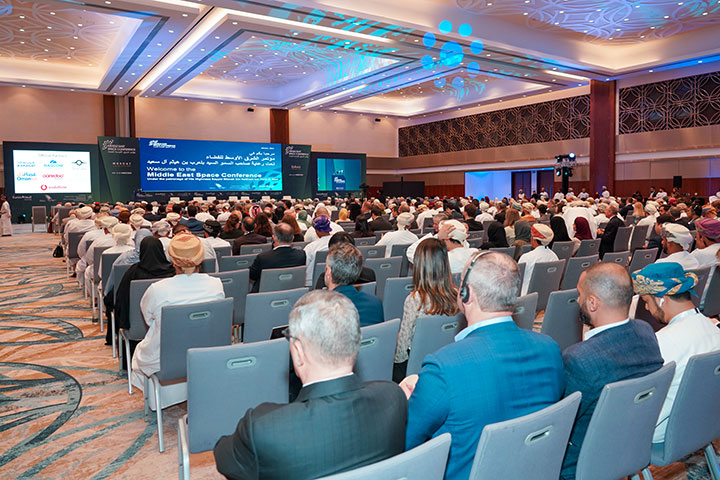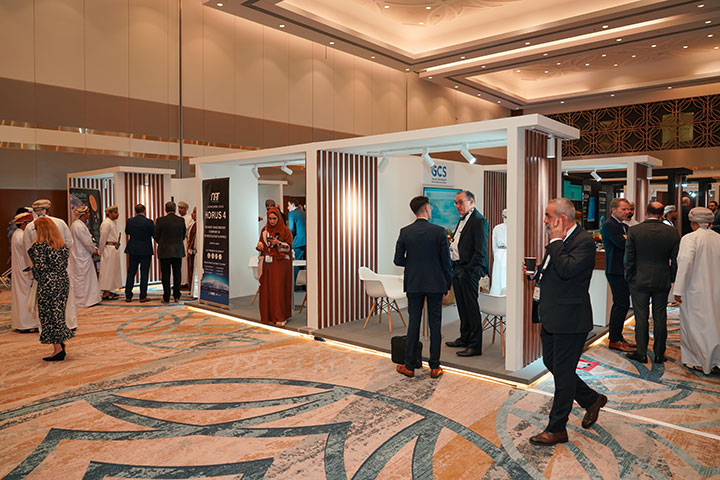 Delegates of the Middle East Space Conference gather in Muscat, Oman from Jan. 8-11, 2024, to explore the regional space ecosystem. (Source: Euroconsult)
Delegates of the Middle East Space Conference gather in Muscat, Oman from Jan. 8-11, 2024, to explore the regional space ecosystem. (Source: Euroconsult)
MUSCAT, Oman — Why is the Middle East considered one of the most dynamic, fastest-growing regions for space worldwide? That question was answered earlier in January when 200 organizations from 23 countries attended the Middle East Space Conference (MESC) the first event of its kind hosted by Euroconsult and Sultanate of Oman’s Ministry of Transport, Communications and Information Technology (MTCIT).
In 2023, governments in the region spent an estimated $1.4 billion on space in 2023, a figure that is expected to surge $2.7 billion by the end of the decade, according to Euroconsult research. This pursuit of space leadership not only coincides with the vision of a diverse, digital economy being pursued by the governments of Bahrain, Oman, Saudi Arabia and the United Arab Emirates and others, it also comes at a time when next-generation space technologies are reaching maturity.
Emerging space powers are finding an increasingly diverse commercial ecosystem to leverage various orbits, technologies and advancements across technology sectors to create a broader range of services, applications and capabilities that are more accessible—and interoperable—than so-called “Old Space” technology.
Expanding into Multi-Orbit and Multi-Service
“The whole industry has changed in the last 4-5 years,” said Arabsat President and CEO Alhamedi Alenezi during a satellite operators panel on broadband connectivity. “It previously was like a closed community providing certain services and certain price and service specifications. But recently … it’s similar to Fintech and banking … where they started providing new services.”
In recent years, legacy operators, like Arabsat, have expanded into new services to keep up with market disruptions by new LEO constellations. At the same time, that disruption has led operators to consider user expectations across verticals and how to meet the growing demand for connectivity. In that context, the long-time GEO operator Arabsat is “expanding multi-orbital, multi-service” offerings to commercial end-users and regional governments. This includes partnerships with LEO constellation operators Loft Orbital and Kineis on Earth observation and IoT data services respectively.
The ability to utilize multiple resources—orbits, applications, network infrastructures, service models, etc.—has unlocked greater efficiencies overall. Regional GEO operator ABS, which recently rebranded as Agility Beyond Space, has been focused on the efficient use of existing GEO capacity for various space and ground solutions while also embracing network virtualization—a tactic that has improved telecommunications industry efficiency dramatically.
“In the past, a lot of inefficiencies in our industry and the high cost was because the only tool we had was a hammer,” said ABS EVP of Global Business Development and Strategy Patrick French, referring to broadcast GEOs. “Now, the industry is growing. We’re developing new tools in space that are more efficient and better at serving the needs of different clients. And this is what’s driving the growth of the industry.”
Making Space Accessible through ‘Real Interoperability’
Other operators, like Rivada Space Networks, are looking to expand the role of satellite by tapping into common standards used in the broader world of telecommunications and IT. The company is working to deploy “the first MPLS network in LEO” using optical inter-satellite links and a secure “outernet” architecture to deliver reliable satellite communications solutions to enterprises and governments. It also aims to leverage 5G non-terrestrial network standards.
The purpose of tapping into standards like MPLS and 5G is to take down the barriers to entry for using a satellite network, Rivada CEO Declan Ganley told Constellations. “I’m about real interoperability,” he said. “When you’re architecting a network, you want it to be compliant with as many of the standards as you can. MPLS is something that all the carriers want and understand. …It’s plug-and-play in a way that other services are not yet plug-and-play.”
During a panel with other satellite operators, Ganley argued that satellite should have a much larger portion of the communications traffic than it does currently, considering the advanced capabilities of new constellations. However, the complexity of bespoke systems and lack of user-friendly technology have been an issue. “If you look at the overall share of the communications…market that satellite has had traditionally, it’s been tiny,” Ganley said. “Once you can provide MPLS services and service level agreements, that changes the game.”
Digital Transformation of the Ground Segment
Progress is also occurring in the ground segment to drive efficiencies and expand the reach and scale of space networks. Ground technology vendors are looking to digitalization and the development of interoperability standards, like DIFI, 5G and others, as a way to take advantage of in-space advancements, like software-defined payloads or flexible payloads and multi-orbit missions.
 Space technology vendors and service providers exhibit at the Middle East Space Conference in Muscat, Oman. (Source: Euroconsult)
Space technology vendors and service providers exhibit at the Middle East Space Conference in Muscat, Oman. (Source: Euroconsult)
Kratos Senior VP for EMEA Bruno Dupas noted the arrival of flexible payloads was a “real disruption” to the industry that also exposed some of the weaknesses of legacy, hardware-based ground systems. “If you look at industries other than space, they’ve addressed this issue of flexibility with digitalization,” he said during a panel discussion.
“Digitalization of the ground segment is a key driver and a key change in the industry, right now,” said Dupas. “The good news is, this is being aligned with what the telecom industry is going to do.”
D2D Anticipation
Satellite direct-to-device (D2D) or direct-to-handset connectivity is another technology spurring significant interest among regional MNOs.
During a panel on developments in the satcom service market, Tariq Al-Lawati, Head of Technology, Governance and Planning at Vodafone, noted the potential for D2D to help tap into unserved markets, even if those markets are limited. “We see this as a big game-changer in the industry,” he said. “This opens the opportunity not only to serve the unconnected but opens the opportunity to serve industries like oil and gas, fisheries, agriculture and logistics.”
There was also some indication that MNOs view direct-to-mobile connectivity as a potential cost-saving measure, depending on bandwidth allocations. Speaking about the traditionally high cost of satellite service, Ali Al Hashmi of Omantel noted, “We are pushing more to get cost optimization. So that is why we expect in the future that the handsets will go directly to the satellite as an ecosystem.” Al Hashmi cited 3GPP standards that are moving in that direction and repeatedly emphasized the importance of satellite operators and handset manufacturers collaborating on the capability. “The more that there is [growth] in terms of the handset going directly to satellite, it’s better for all of us.”
Regional Demand for Advanced Technologies
The commercial space landscape has become increasingly diverse and ever-more competitive in the past decade, especially amid the more recent period of market consolidation. Many of the governments and organizations in the Middle East that want to expand their space capabilities are seeking partners who can help achieve stated goals, such as digital transformation, ubiquitous connectivity, economic diversification, scientific leadership and space sovereignty. As they look for the most compatible partners, they have a highly dynamic market to choose from.
As Euroconsult stated in a recent white paper on the Middle East space ecosystem, “The significant transformations taking place in the global space sector offer Middle Eastern nations huge opportunities to leverage their national strengths and effectively address national, regional and global challenges. However, as the window of opportunity gradually closes with the advent of a new, post-new space sector cycle, players in the region need to act quickly to seize the opportunities that lie ahead.”
Explore More:
Podcast: The Opportunities, Challenges and Future of the Middle East Space Sector
Podcast: Terrestrial Networks in Space, Inter-Satellite Optical Links and Free Space Optics
How Mega-Constellations Are Impacting Satellite Operators’ Financials
Satellite Operators, Vendors Showcase Integrated Satcom Service Using Telco Standards
